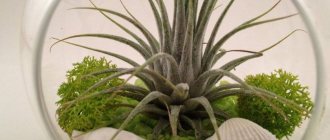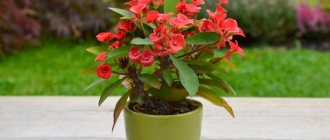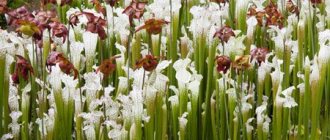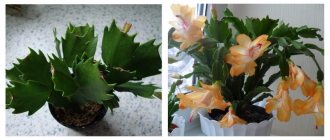Eustoma, or lisianthus, is included in the Gentian family. This is a lush ornamental plant with graceful flowers, very similar to roses. Although eustoma is a perennial plant in its natural habitat, when grown in open ground it can only live for 1 year. In potted culture, its age reaches several years.
Eustoma, or lisianthus, is included in the Gentian family
What does eustoma look like and where does it grow?
Eustoma (from the Latin name - “Eustoma”) has many other names. People call it herbal, Irish, Japanese, French or Chinese rose (not to be confused with hibiscus), and in the USA the plant is nicknamed “Texas bell.”
The flower has strong stems, in most species growing to a height of 1 m. Approximately 50 cm from the ground they begin to branch. Moreover, over 30 buds are often formed on each shoot during flowering. They bloom not at one moment, but one after another, so the Texas rose is decorated with beautiful flowers for a long time and is very attractive.
Looking at the leaves of eustoma, it seems that they are made of wax. This impression is largely due to their bluish color and matte surface. The flowers are large, 5–8 cm in diameter, funnel-shaped. In decorative floriculture, double plant species are more often used, although there are also non-double ones. Their color can be different: white, pink, lilac, plain or with a border. When the flower opens halfway, it looks very much like a garden rose. Later it takes on a resemblance to a double poppy.
Lisianthus grows wild in the Southern Hemisphere: in the southern territories of North America, including Mexico, in the northern part of South America and on the islands located in the Caribbean Sea. It prefers to settle in river valleys, where it receives enough moisture.
Varieties with photos and descriptions
The popularity of eustoma in Russia is only gaining momentum. It is enough to take an interest in the ratings of flower varieties in the most famous specialized stores, and you can understand which flowers of this type attract the most attention. Just to begin with, you need to decide which growing method is an acceptable option.
So, the top 9 most popular varieties of eustoma:
Low-growing varieties, for pot growing, border decoration:
- Carmen F1 Ivory (stem height 25 cm);
- Sapphire F 1, white-pink, height 20 cm;
- Little Mermaid F1 – all colors.
Medium-sized varieties and hybrids for garden decoration:
- Twinkies F 1 (white, cream, purple, yellow, pink);
- Cinderella F1.
The greatest demand is for cut flowers, with a stem length of 70-100 cm. Therefore, they are most widely represented in every flower shop and well-known agricultural company:
- Magic F 1 terry (the hybrid is available in a series of different colors);
- Hybrid Green Alley with an unusual pistachio shade;
- Flamenco F 1;
- Terry apricot.
- "Florida Pink" is a perennial garden variety. Attracts attention with large, profusely blooming pink inflorescences.
- "White Grandiflorum" (Lisianthus grandiflorum). It is distinguished by lush, dense white flowering. It has many flowers on one stem, creating the appearance of a luxurious bouquet. Banquets and weddings are decorated with such compositions.
The tall species includes varieties with a height from 70 cm to 1.5 m.
- “Aurora” is an early flowering variety, reaches a height of about 1.2 m. Beautiful double flowers have bright lilac, blue or white shades.
- "Flamenco" is an unpretentious species, distinguished by its colorful flowers on a large number of buds. Reaches a height of up to 1.3 meters.
- "Mariachi Lime" is distinguished by double, lush, light green flowers.
- Beppin-San is an exquisite variety that has unusual petals on its flowers. They are carved on the edges, airy, like bird feathers, of unusual colors. It can be soft milky or pink in color with a light green center.
- Heidi is a popular variety due to the variety of its shades, of which there are about 15. It reaches a height of up to one meter. The inflorescences are located separately from each other, distinguished by thin large petals. The flowers have a bright red hue.
This variety is suitable for planting in the garden and indoors.
- "Russell" has a beautiful, compact shape. The stems are branched, the leaves are oval-shaped and gray in color. The flowers of the plant are very large, similar to bells. The color palette is varied, there are white, blue, lilac, pink specimens. There are two colors combined. This variety is very popular among gardeners.
- “Flamenco yellow” is an unpretentious variety that reaches a height of 70 cm. It has large yellow flowers that are arranged in a spiral on the shoot. The flower exudes a pleasant aroma. Has early flowering. The flower reaches 7 centimeters in diameter.
The low-growing species includes varieties with a height of 12 to 20 cm.
- “Sapphire pink haze” reaches a maximum height of 10-15 cm. The leaf blade has a glossy surface and a bluish tint. Large white-pink flowers have a funnel shape.
- “Riddle F1” - the plant has an incredibly beautiful, compact bush about 20 cm high. The flowers are multi-layered, light blue in color, and their structure resembles a rose. The petals have a satin surface. The flowers are located opposite on the shoot. Eustoma is adapted to grow indoors and in open ground.
For flowering to appear in July, they try to plant no later than the beginning of March.
- “Fidelity F1” is distinguished by its small growth, up to 20 cm. A large number of small white flowers are arranged in a spiral.
- “Echo” reaches a maximum height of 60 cm. Thanks to flowers of different shades, and there are about 11 of them, both plain and with a smooth transition from one color to another, it is widely used in creating bouquet arrangements.
- "Mermaid" (Mermeid) is a dwarf species, reaching only 15 cm. Used for growing in pots. It has gorgeous double blooms in blue and pink tones, as well as white and milky shades.
- “Little Bell” is a very simple flower in appearance, but in a composition with other lush counterparts it looks very strict and unique. It is distinguished by lilac flowering. Suitable for growing in pots.
How to grow eustoma at home (video)
We also recommend reading:
16 most popular indoor plants Physalis: description of species and varieties, technology for growing from seeds Spruce in landscape design: the best ornamental varieties and characteristics of cultivation Kalanchoe: description of types and characteristics of care at home
Diseases and pests
Indoor eustoma is susceptible to fungus gnats, which are dangerous distributors of fungal diseases, to Fusarium wilt, powdery mildew, and gray rot. During the process of growing the plant, periodically carry out preventive spraying with special preparations. But if you do find pests, do not delay treatment. The following drugs are effective: Saprol, Topsin, Mospilan, Fitoverm, Confidor. Spraying is carried out 2-3 times.
As you can see, indoor eustoma is a rather whimsical plant. Growing and caring for it will require some effort from the owners, but believe me, you will be rewarded with a magnificent result when the eustoma blooms.
Popular types and varieties of eustoma
Botany knows about 60 plant species. Two of them are used in floriculture: eustoma grandiflora and Russell. Moreover, some scientists believe that this is the same species.
Mostly tall varieties are used for growing in the garden. They look good in flower beds and as cut flowers. The height of the stems is more than 70 cm:
- Aurora: reaches 90–120 cm, and the main advantage of the variety is its early flowering - it occurs 3 weeks earlier than the others;
- Echo: much lower - the height of the stems is only 70 cm, but they branch strongly and form a spreading bush, and the color of the flowers can be very diverse, including two-tone.
Indoor eustoma: cultivation and care
Seeds should be sown at home in the first half of December. If you do this at this time, by the end of August you will have buds blooming that you can't take your eyes off. Disposable cups are used for planting. The substrate should be loose, with a peat component. Soil with the addition of coconut is excellent.
The seeds are laid out on the surface of the soil, which is pre-watered and then sprayed. After this, the cups should be covered with film and moved to a warm place (+25 °C). Once a day, the film is removed for a few minutes for ventilation, and the soil is moistened. After one and a half to two weeks, indoor eustoma produces its first shoots. Growing and care from this point on become more complicated.
The film is removed, and a lamp is installed above the young shoots at a height of no more than 35 cm. When the seedlings reach 15 cm in height, they can be planted in permanent containers. A ceramic pot is suitable for this. Lay drainage (expanded clay) in a 3-4 cm layer at the bottom. Then the container is filled with soil mixture, leaving it three centimeters short of the top edge.
Features of growing eustoma
The Irish rose has important features that influence its method of reproduction. The main one is the unusually delicate root system.
From tubers
It is impossible to propagate eustoma by dividing the rhizome. If the fragile root system is affected, the mother plant will be destroyed and new seedlings will not be obtained. This makes it very difficult to breed lisianthus - it can only be done with seeds. But, when you don’t want to bother with growing seedlings, you can try to find young seedlings that are more tolerant to replanting in a flower shop or from amateur gardeners. But even then, the risk that the plant will die remains.
From seeds
Most gardeners propagate eustoma by seeds - both for growing in the garden and for potting. This process requires a lot of attention, caution and painstakingness . But if you follow all the recommendations, the idea will definitely turn out to be a success.
The difficulty of propagation lies both in the risk of injuring the sensitive roots of the seedling and in the microscopic size of the seeds themselves. According to rough estimates, 1 g of seed contains 23,000 pieces. Seeds that are sold in stores undergo a special treatment that increases germination: its percentage is 60%, which is quite good and makes it possible to grow a capricious plant.
How to collect eustoma seeds
Now let's move on to the more serious part of the growing process - collecting seeds and further manipulating them. The seed pods of the flower are formed after pollination. In open ground, of course, plants are pollinated by insects.
If you are breeding lisianthus at home, then solving this problem with a regular (soft) brush will not be difficult and will not take much time. As is the case with other flowers, the seed pods remain in the place of dried buds that are not removed from the shoots.
They are very small in size; those sold in stores are already “rolled up” in a special thin shell, which consists of components that promote better germination and growth of plants.
Gallery: eustoma (44 photos)
Eustoma planting technology
To succeed, you need to familiarize yourself with the rules for planting French rose seeds and follow them. Eustoma is capricious during the growth period and requires certain conditions, so the “instructions” must be strictly followed.
In open ground
If you want to decorate a flowerbed in the garden with eustoma, you will have to take care of sowing seeds for seedlings in early spring: approximately at the end of February or at the very beginning of March. So the plant will bloom in mid-summer or in August - it largely depends on the weather. For planting, use containers (can be replaced with other suitable containers) and soil mixture for flower plants. It must be sterilized and have a low nitrogen content. Soil with a pH of 6-7 is optimal.
The process of growing seedlings consists of several stages. Each of them is important!
- Try to distribute small seeds evenly over the surface of the ground in a container. There is no need to bury or sprinkle them, just gently press them to the soil with your palm. The container is covered with polyethylene or glass to create a greenhouse effect. Leave a small gap for ventilation. In early spring there is usually not enough light, and young seedlings will need 10 to 12 hours of daylight. Therefore, it is recommended to place them on a south or south-west window and additionally illuminate them with phytolamps. The temperature during the day should be around 20°C, and at night drop to a maximum of 14°C.
- Caring for a container with planted eustoma involves spraying the seeds as the soil dries with warm water from a spray bottle. This may not be required, because condensation collects inside the greenhouse. You need to focus on the condition of the earth.
- In a maximum of 2 weeks, the first seedlings should appear. After this, the shelter is removed so that they do not grow into “greenhouse plants.” They are periodically sprayed with a solution of “Fitosporin” to prevent diseases.
- After the appearance of 2 full-fledged leaves (approximately 1.5 months after planting - in April), the seedlings are picked and planted in separate pots. The preferred diameter of the dish is about 5 cm.
- At the end of May or the first ten days of June, young plants can be transplanted into the ground without damaging the roots. Therefore, the earthen lump must be removed carefully and try not to destroy it.
Reproduction of Eustoma
Reproduction of indoor Eustoma occurs only with the help of seeds. Reproduction of Eustoma by cuttings, layering and dividing the bush is not possible.
Growing Lisianthus from seeds
Growing Eustoma begins with purchasing quality seeds.
If you are going to use the seeds of your faded plant, keep in mind that they only become suitable for planting after a year .
You can plant seeds for growing Eustoma at any time of the year, but it is better in June-July, so that by autumn the bush will form and bloom profusely and colorfully in winter. Quite a long time passes from the moment the seeds are planted to the start of flowering.
Eustoma seeds
Eustoma's seeds are very small - there are more than 10 thousand of them in one gram. Therefore, it is better to purchase Eustoma seeds in special capsules, in which a nutritious mixture of peat, sand and fertilizer are balanced for maximum effective seed germination. Place seed capsules in prepared, well-moistened soil (in a pot or container) at a distance of at least 5 cm from each other. Cover with transparent film. Place in a warm, bright place to germinate seeds.
You can also purchase the seeds in yeasted form. There, several seeds are placed in one ball with a nutrient mixture. It is convenient to sow such peas as described above. Or you can plant Eustoma seeds for seedlings in peat tablets. The container with tablets maintains the necessary humidity and temperature, it is convenient to ventilate, it is clearly visible how the seeds germinate and the seedlings develop.
Yeasted eustoma seeds
If you decide to plant your seeds for seedlings in a container or container with nutritious soil, a mixture of sand and peat in equal parts is suitable for you. Place the seeds on the surface of moist soil and press them lightly. Cover the container with transparent film or a lid.
This may be interesting: Clerodendrum - home care
The first shoots will appear no earlier than in 2-3 weeks. The soil should not be too dry or too wet. It is better to moisten the soil after the first shoots appear in the morning - there is a risk of blackleg disease. To prevent the disease, you can spray Eustoma seedlings with a solution of foundationazole - 1 tsp. for 1 liter of warm water. When the sprouts begin to sprout, begin to accustom them to new conditions - open the film more often for ventilation, reduce watering. Spray with Zircon or Epin for rapid growth of sprouts, since in the first months Eustoma grows very slowly.
Growing Eustoma in peat tablets
Only after a couple of months, when the seedlings have grown a little, can they be transplanted into separate pots. It is necessary to replant by picking up the sprout along with a lump of earth, trying not to damage the fragile roots of the tiny bush. If the seedlings are sitting in a peat tablet, carefully remove the tablet from the shell and place it in a container with prepared soil.
Transfer
Although Lisianthus is a perennial flower, it does not tolerate transplantation; try not to disturb its root system without good reason.
Secrets of caring for eustoma in the garden
In order for eustoma to grow into a beautiful bush, it needs to be properly cared for. For example, it is necessary to pinch the top of the main shoot after 8 leaves appear, so that the plant bushes more strongly. Since buds form on all shoots, the more there are, the better! And flowers that show signs of wilting should be cut off immediately, because this stimulates the formation of new ones. Flowering will become more abundant and longer.
Frequency and rules of watering
The plant is watered, observing the condition of the substrate. This largely depends on climatic conditions. The soil should be moistened when it dries 2 cm deep. More frequent watering can lead to rotting of the tender roots.
Feeding eustoma in the garden
The time for fertilizing comes 1 month after the seedlings are moved into open ground. At this moment, the rooting period ends and the eustoma begins to actively “grow.” You can use universal fertilizers to fertilize ornamental flowering plants. But when preparing the solution, you should make the concentration 4 times weaker than indicated in the instructions for the product (for example, take a quarter cap instead of a whole one).
Be sure to pinch the top of the main eustoma shoot after 8 leaves appear, so that the plant bushes more strongly.
Disease prevention and pest protection
Eustoma is vulnerable to diseases and pests, so you must take preventive measures:
- Use only sterilized soil for growing seedlings.
- Before planting in open ground, seedlings are treated with Fundazol.
- The seedlings are sprayed several times with Epin or Zircon. They will strengthen the plants, which will make them more resistant to both unfavorable conditions and diseases.
- Do not allow the soil to become waterlogged. Although the French rose is a tropical plant, it doesn't like it. Due to excess moisture, fungal diseases of the roots and lower parts of the stems develop, which can destroy the entire plant.
- Weed to ensure good ventilation at the base of the shoots.
- The use of the drug "Ridomil Gold" allows you to prevent Fusarium wilt caused by the activity of the fungus.
If infection cannot be avoided, chemicals should be used to treat diseases and destroy parasitic pests.
Preparing eustoma for winter
In open ground, the French rose dies during wintering. The only options for “rescue” are to carefully transplant it into a pot and use it as a houseplant, or cut it, leaving two internodes on the main shoot, and place it for the winter in a cool but bright room (with a temperature of 12 °C) with periodic watering. The chance that the eustoma will survive the transplant is very small, but still exists.
Caring for a plant on the window
Growing and caring for indoor eustoma are matters that require attention, time and effort. The flower will not forgive a careless attitude; it will wither.
How to water
Eustoma flower
There is one important condition for watering home lisianthus: under no circumstances should you allow moisture to get on the leaves and flowers of the plant. The water pours strictly onto the ground. Otherwise, there is a high chance that the foliage will rot.
Watering should be moderate. Both overdrying and waterlogging are bad.
Important ! As a top dressing, you can add a little lemon juice to the water for irrigation - from 3 to 5 drops per liter of liquid.
How to feed
A month after transplanting into a permanent pot, eustoma seedlings can be fed. For these purposes, take mineral fertilizer for flowering flora. At the same time, it must be completely dissolved in water. The concentration needed is lower than recommended on the label. Lisianthus has very delicate roots that are easy to burn with excess fertilizer. It is recommended to fertilize the flower every month during the flowering period.
How can you feed eustoma?
How to form a crown
In the first flowering season, it is better to focus not on flowers, but on the formation of the crown of the eustoma bush. To do this, experienced flower growers recommend trimming the buds before they open. In this case, at the end of the period of active growth, you will get a properly formed bush. Next year it will no longer waste energy on rooting and growing branches, and will be able to immediately begin to bloom.
This point can be skipped if the original plan was to grow eustoma for one flowering. With a high degree of probability, upon completion, the plant will only be suitable for discarding.
Care during the dormant period of eustoma
To extend the life of this flora, you should provide it with proper wintering. In particular, four points must be observed:
- Temperature. In summer, lisianthus is comfortable at 20-25°C, but with the arrival of autumn it begins to gradually decrease - a sharp temperature change will kill the plant. In winter, the flower pot should be at a temperature of 10-15°C.
- Watering. In winter, the eustoma is watered generously with water at room temperature, but rarely (in summer, the opposite is recommended). Be sure to immediately remove excess liquid from the pan. Repeated watering is carried out only after the first 3 centimeters of soil on top have completely dried.
- Trimming. After the plant has flowered, its stems are cut off. Only three internodes and several pairs of leaves are left. So it goes to spend the winter.
- Fertilizer. In winter, lisianthus is not fertilized.
Different varieties of eustoma
Despite the fact that there is quite a lot of fuss with home eustoma, it is gaining popularity as a house plant. Because of the beauty of its flowering, people agree to care for the capricious flora, spending their time and energy.
Caring for indoor eustoma at home
Eustoma is a difficult plant. It requires careful handling and attention. In indoor conditions, the Irish rose can live for several years. In this case, transplantation is done in extreme cases - there is a high probability that the flower will die after it.
Temperature, humidity and lighting
The plant is not like most of its counterparts from the tropics. Eustoma needs a bright but cool room. The optimal temperature is from 19 to 22 °C , and the location is on the east or west window. High air humidity will harm the eustoma, because it can provoke the appearance of rot, so good ventilation is required.
Requirements for planting pot and soil
The best soil for indoor eustoma is a mixture of bark humus and peat, taken in equal quantities. In extreme cases, you can use a universal soil mixture. For a plant, when transplanting a young seedling, take a pot “for growth”, because the French rose may not survive re-transplantation. A drainage layer is required at the bottom.
In indoor conditions, the Irish rose can live for several years.
Watering eustoma at home
Eustoma requires moderate but regular watering. The top layer of soil should dry out to a depth of 1.5–2 cm. Use soft water, standing for at least 24 hours. Lisianthus does not need spraying and can even cause serious harm.
Feeding indoor eustoma
Feeding is needed during the period of active plant development and bud formation. Use complex mineral fertilizers diluted in water. They need to be made 4 times weaker than indicated on the package.
Varieties
Low-growing varieties of Eustoma include:
- Eustoma Riddle is a low compact bush, reaching 20 cm in height. Blooms profusely with double light blue flowers.
- The Mermaid variety is a miniature compact species of Lisianthus, the crown height of which does not exceed 15 cm. It does not require pinching. This hybrid blooms with simple flowers with a diameter of up to 6 cm in a variety of shades: white, light pink, lilac and blue.
- Little Bell is a densely branching bush of miniature size, reaching a height of 15 cm. The flowers are small, simple, funnel-shaped, of all kinds of colors. This variety is valued for its abundant, long-lasting flowering. You don't have to do pinching.
- Eustoma Fidelity is a low indoor plant, no higher than 20 cm in height. It is distinguished by a multitude of snow-white small flowers, which are arranged in a spiral on the flower arrow.
- Variety Tenderness is a beautiful bush with an elegant stem up to 20 cm, on which satiny petals are arranged in a spiral. Blooms with pink flowers.
- The Little Mermaid has very small bushes, up to 15 cm in height, blooming with white, light blue or pink flowers.
- Eustoma "Florida Blue" - characterized by abundant blue flowers.
- Variety Florida Pink - this very beautiful, low indoor flower blooms profusely with light pink flowers. In a pot it looks like a bouquet with wonderful miniature roses.
This may be interesting: Spathiphyllum or Women's happiness: description, types and varieties
Little Bell Mermaid The Little Mermaid Fidelity Florida Blue Florida Pink
In addition to low-growing ones, flower growers also practice growing tall indoor Eustomas:
- Eustoma Cinderella - bush height up to 50 cm. Blooms with double flowers of delicate pink or yellow color.
- Variety Twinkie - stem height is not higher than half a meter. It blooms with white, yellow, pink or purple flowers of extraordinary beauty.
- Eustoma "Mariachi Lime" - the height of the bush reaches a meter. The flowers on it are double lime-colored.
- Echo is a medium bush, grows up to 70 cm in height. Flowers of pink, yellow, lilac or white are displayed on a strong stem.
Twinks Mariachi Lime Echo
The most popular Eustoma varieties for growing at home are large-flowered. Their inflorescences consist of many large beautiful skirt-shaped flowers of the most impossible colors: snow-white and purple-red, violet and lilac, lilac and light yellow, blue and light blue.
Features of caring for eustoma in Siberia
In the special climate of Siberia, it is difficult to grow a full-fledged eustoma, because it does not tolerate cold and heat. To protect it, use small tricks:
- When waiting for cold weather, cover with film.
- During hot weather, artificial shading can be created.
- Do not water the plant for several days after rain.
- Immediately trim off wilted buds.
So there is every chance to see eustoma in its full glory on your site.
Growing seedlings in peat tablets
How not to damage tender seedlings? The only, albeit somewhat expensive, way is to grow eustoma in peat tablets. This kind of forcing of seeds eliminates damage to the root system, because the sprouts immediately, from the first days, take root in the tablet, which is also a nutrient soil. How to grow eustoma seedlings in peat tablets? Taking into account the peculiarities of the root system and the difficulties with uniform distribution of seeds, each of the chosen methods is painstaking work that requires patience and accuracy.
Step-by-step instruction:
- Place a grate or any suitable stand with holes in the tray to hold the peat tablets above the water.
- Fill the pan with water or a solution containing biosporin, growth stimulants, other microfertilizers and protective preparations. The liquid level should barely touch the grate.
- Place the tablets on the rack, leaving a small space between them, and leave to swell.
- After this, put 2-3 seeds on each tablet. After emergence and rooting, it will become clear which shoots will be weak. They will have to be removed so that they do not interfere with the development of stronger shoots.
- The tray with peat tablets and seedlings must be covered with film or any transparent, airtight material. Seeds need to be provided with moisture and diffused sunlight (or artificial lighting).
- Ventilate the seedlings daily for an hour. Constantly maintain the required temperature and avoid drafts. If necessary, add room temperature water to the tray and monitor the moisture content of the tablets.
- In the phase of appearance of two pairs of true leaves, tablets with seedlings can be placed in prepared soil for growing.
- When the seedlings get stronger and the third pair of leaves appears, the young seedlings are transplanted to a permanent place, along with a lump of soil, into moist soil. Land in the evening.
When transferring tablets into the soil, do not bury the above-ground part of the seedlings. Eustoma does not tolerate picking. Picking is carried out when the plant reaches a height of at least 2-3 cm. Usually it reaches this height 7-8 weeks after sowing. Containers are prepared with a capacity of 0.2-0.3 liters. After seedlings, special care is needed, because the root system has been affected.
Further care consists of timely but moderate watering. Air humidity must also be maintained at 70-75%, but the plants should not be irrigated - it is enough that there is always water in the pan, which will gradually evaporate at 20-240C. The roots should not reach the water in the pan. Seedlings should be fertilized 10 days after transplanting into the soil.











